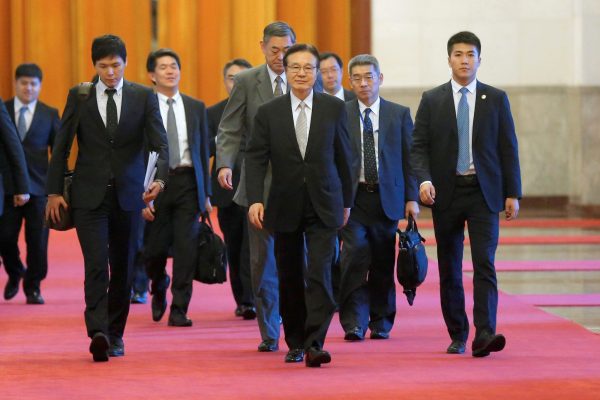Leading experts on Japan’s foreign policy have deemed it ‘the most ambitious reorganization of Japan’s foreign and security policy apparatus since the end of World War II’.
Over the past half-decade, the NSC has come to play a central role in shaping Japan’s strategic trajectory that has attracted so much global attention in the Abe era. Though its existence and structure hardly make for eye-grabbing headlines, appreciating the NSC’s behind-the-scenes role is crucial to understanding some of Japan’s major policy decisions in the past five years, as well as how the country plans to cope with current and future challenges.
The NSC facilitates top-down decision making on national security issues, deeper integration and inter-agency coordination for strategic planning and crisis management, and a more robust, political demand-driven intelligence cycle. It is designed to be a Cabinet-based ‘control tower’ for national security decision making. The council also serves longer-term efforts by Japan’s leaders to expand and strengthen the ‘prime ministerial executive’ at the expense of its historically powerful bureaucracy.
Though established under Abe, the NSC was the culmination of longer-term trends. Critics had recognised institutional deficiencies for decades. The NSC’s immediate predecessor, the Security Council, was judged to be insufficient to handle increasingly severe and diverse security challenges requiring more effective ‘whole-of-government’ decision making, planning, intelligence gathering and assessment.
Salient drivers on the eve of the NSC’s establishment included the March 2011 ‘triple disaster’ in Tohoku, a January 2013 hostage crisis involving Japanese citizens in Algeria, North Korea’s repeated nuclear weapons and ballistic missile tests, and grey zone challenges such as China’s provocative operational assertion of its sovereignty claim to the Senkaku/Diaoyu Islands after September 2012. Considering the difficulty of responding to these diverse crises, Japan’s leaders judged that an institution better suited to formulate and carry out a more proactive, comprehensive and ‘whole-of-government’ strategy was a national security imperative.
Thus, the NSC’s establishment was motivated by a desire to more flexibly and independently cope with a rapidly changing, increasingly complex and ever more uncertain security environment in East Asia and beyond. It was also based on an understanding of national security that recognises the importance of threats beyond traditional military or defence affairs such as cyber technology, space, finance, and man-made and natural disasters (such as 3/11).
The NSC’s most significant institutional innovation is its core Four-Minister Meeting comprised of the prime minister, chief cabinet secretary and ministers of defence and foreign affairs. Meetings of these national security principals can be expanded as needed — usually through the Nine-Minister Meeting framework inherited from the NSC’s predecessor or the Emergency Situation Minister Meeting. The NSC met 48 times in 2016 and 46 times in 2017 — a rate dwarfing that of analogous meetings in the pre-NSC era.
The National Security Secretariat (NSS) provides support to the NSC. The NSS was established in 2014 and staffed primarily with career civil servants from the ministries of foreign affairs and defence, as well as officers from Japan’s Self-Defense Forces. It is organised into three regional and three functional teams addressing policy integration, crisis management, information and intelligence sharing, coordinating with foreign counterparts and ad hoc project support.
Together with the NSS, the NSC has become the nexus for major decisions and draft legislation defining Japan’s foreign policy and security posture. This includes Japan’s 2013 National Security Strategy, the controversial July 2014 reinterpretation of Article 9 of Japan’s ‘Peace Constitution’ to enable limited exercise of collective self-defence, and a major package of security legislation to support this reinterpretation passed in September 2015. The NSC and the NSS also play a key diplomatic function by serving as the Cabinet-based contact point for foreign governments.
While it appears to be functioning well to date, the NSC’s longer-term significance will hinge on its future form and function, especially after Abe and his inaugural NSS secretary-general, close advisor and retired career diplomat Shotaro Yachi, are no longer running the show. Japan’s 2013 National Security Strategy — its first-ever — as well as the NSS’s ability to cooperate with Japan’s historically powerful ministries and agencies, are two other important variables to watch.
The NSC has proved to be one of Japan’s most significant institutional reforms in decades. It is also the key achievement of the Abe administration’s ambitious agenda to strengthen political leadership of Japan’s national security decision making. Japan’s leaders face an increasingly complex, challenging, and fast-evolving regional security environment. Time will tell if the NSC is up to the challenge.
Adam P Liff is Assistant Professor of East Asian International Relations at the Hamilton Lugar School of Global and International Studies, Indiana University. He is also a Nonresident Senior Fellow at the Brookings Institution.
This article is based on a more in-depth analysis first published here in the peer-reviewed academic journal Japanese Studies.

